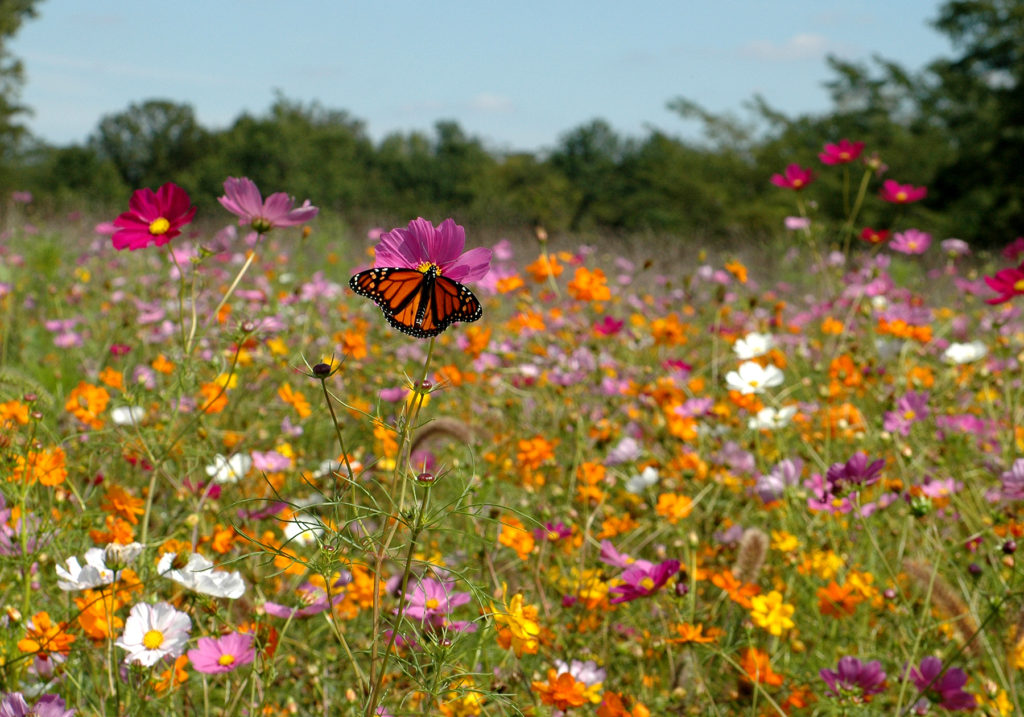Conservation programs offered to help pollinators, forests

A monarch butterfly takes nectar from a coreposis flower. Photo from USDA.
POMEROY, Ohio – Local agricultural producers and rural landowners can help struggling pollinators like Monarch butterflies and honey bees, and restore oak-hickory woodlands in southeastern Ohio, under programs administered by the U.S. Department of Agriculture’s Natural Resources Conservation Service.
According to the NRCS, more than 80 percent of the world’s plants need pollinators to survive, including many that provide the food we eat. But many pollinators like honey bees and Monarch butterflies are in trouble. That’s why NRCS works with private landowners to create food and habitat for pollinators on farms and in forests.
The NRCS provides technical and financial assistance through its Environmental Quality Incentives Program (EQIP) to help producers voluntarily implement conservation practices such as planting cover crops, planting milkweed, and planting wildflowers, and native grasses in buffers and areas not in production. In total, more than 3 dozen NRCS conservation practices provide benefits to pollinators.
This is an opportunity to assist producers in increasing monarch butterfly habitat. Planting milkweed and nectar-rich plants not only benefits butterflies, but strengthens agricultural operations and support other beneficial insects and wildlife.
Honey bee habitat can also be increased through NRCS programs. The honey bee pollinator effort will provide floral forage habitats to benefit hive nutritional health as part of an overall effort to increase the health of honey bee populations.
In an effort to restore oak-hickory woodlands, NRCS and its conservation partners created the ‘Collaborative Oak Management’ project in southeastern Ohio. The project area includes the Wayne National Forest and Ohio State Forests, as well as privately held forest land. Approximately 73 percent of the land within the Wayne National Forest is privately owned and interspersed within the forest boundaries. However, the boundaries of private and public land don’t exist for invasive species and wildlife. The Collaborative Oak Management project provides a mechanism to restore oak-hickory woodlands seamlessly across both public and private land.
Woodland owners in Adams, Athens, Gallia, Hocking, Jackson, Lawrence, Meigs, Monroe, Morgan, Muskingum, Noble, Perry, Pike, Ross, Scioto, Vinton, and Washington Counties may apply for the EQIP Oak Management program.
NRCS uses EQIP to help restore privately owned oak-hickory woodlands owned. Woodland owners in the project area can receive both technical assistance from professional foresters and financial assistance to implement conservation measures recommended by foresters using EQIP. Conservation measures that promote oak and hickory growth include the control of invasive plants and undesirable trees like the highly invasive non-native tree of heaven. Eligible practices include brush management, tree plantings and forest stand improvement activities.
Any eligible agricultural producer or rural landowner can sign up for EQIP, but applications submitted by entities, such as agricultural producers applying as a corporation, must have a DUNS (Data Universal Numbering System) number and an active SAM (System for Award Management) registration status when applying, a process that may take several weeks. Applications cannot be processed without this information.
Information about EQIP, is available on the Ohio NRCS website. Producers in Meigs County interested in the program should visit their local USDA Service Center at 113 East Memorial Drive, Suite D, Pomeroy, Ohio to submit an application, or contact Carrie Crislip, District Conservationist at 740-992-6646, or [email protected].






